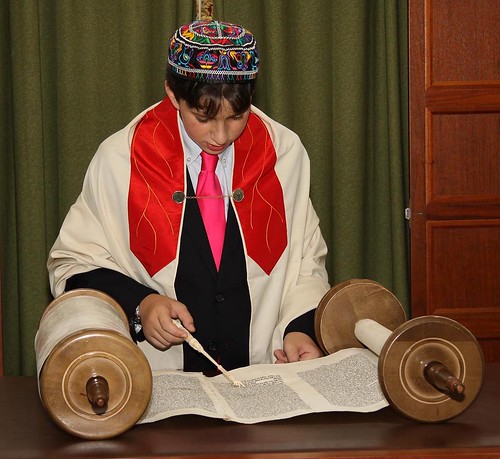Normal life is slowly resuming, post Bar Mitzvah. Getting everyone ready was a challenge, butmget ready we did, and Harry did great. He completely nailed his portion, the blessings, and Haltarah. His D'var Torah was terrific, too. The rabbi had never heard of a kid doing a D'var Torah quite like this, before! As my friend Sharon said, it may be the first, ever, D'var Torah that everyone listened to, not just the family!
The Bar Mitzvah boy, in his lovely tallit (I hesitate to say that, but everyone else did....so.....I'm still not satisfied with it, but it is reasonably pretty! I love the way guys will wear pretty tallitot!)
 Here is the D'var Torah.
Here is the D'var Torah. Va-Yelekh D’var Torah
by Harry
September 24, 2011
(Deuteronomy 32:28-30)
Good morning
I wrote my d’var torah in verse
But please don’t get upset and curse
I have trouble writing
So don’t start up fighting
It took me a long time to rehearse
There once was a prophet named Moses
He dreamed he had piglets for toeses
He was like a parent
The Jews were still errant
So they just ended up without roses
God said to Moses “you’ll die
Tell the people I’ve chosen, Don’t Lie!
Would you please just behave
And try to be brave”
So the Jews crossed the river to cry
When they were ready to have a new home
They wrote it all down in a tome
We call it the Torah
They all danced the Hora
And then entered the land plated chrome
When they were ready to start their new life
They were not riddled with strife
Just like graduation
It’s a new situation
Like normal people in modern-life
The Jews were like kids leaving school
Convinced that they’re really quite cool
They must be proficient
To be self-sufficient
And sometime their own land they might rule
Right now I would just like to thank
Mom and Dad for filling my tank
Beth, Wendy, and Teddy
Grandma but no Eddy
And then of course there is Frank
Thanking someone is not easy
Quite often it gets rather cheesy
Thank you all for coming
Rosalie for her strumming
Hey Michael and Joan are you queasy?
(Rosalie is the guitar playing cantor, Michael the Rabbi, and Joan, his teacher)








